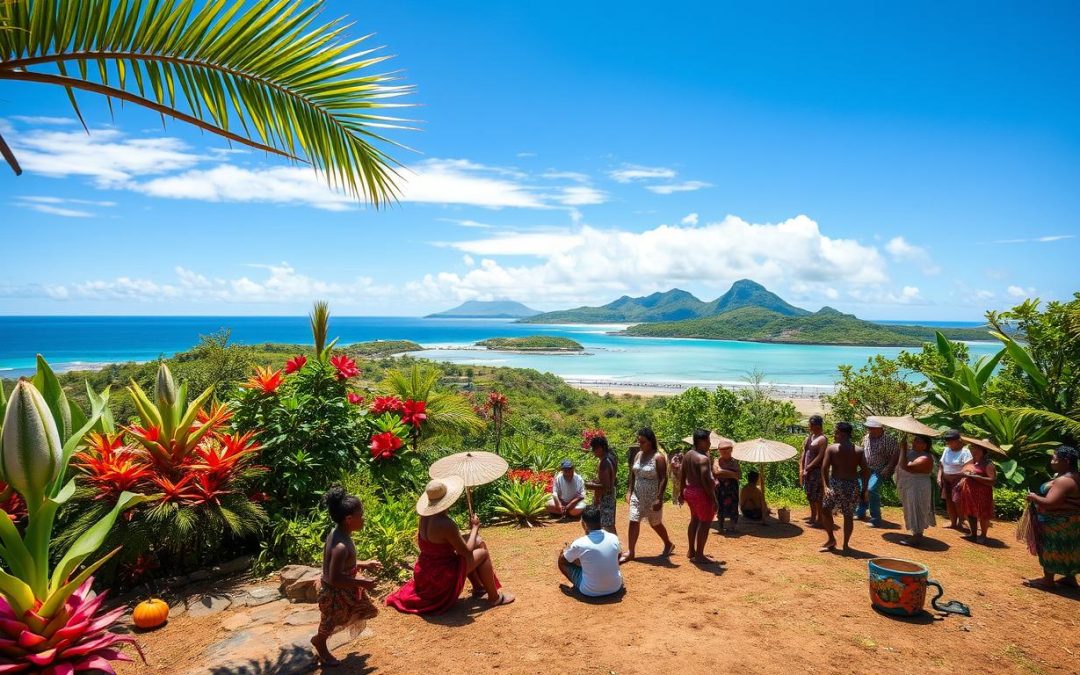Have you ever thought about how a small Pacific nation keeps its languages alive? The Cook Islands show how multilingualism can thrive in a small place.
In the South Pacific, the Cook Islands have a special language scene. They have five living languages, showing a strong effort to keep their culture alive. English and Cook Islands Māori are official, blending tradition with today’s world.
The Cook Islands’ language world is lively but also at risk. While most people speak English and Cook Islands Māori, there are many other languages too. Each one shares stories of survival, identity, and cultural strength.
Key Takeaways
- Five living languages exist in the Cook Islands
- English and Cook Islands Māori are official languages
- 86.4% of residents speak English
- 76.2% communicate in Cook Islands Māori
- Linguistic diversity reflects cultural richness
Overview of Language Diversity in the Cook Islands
The Cook Islands are a fascinating example of language diversity in the Pacific. Located in Polynesia, they have a mix of indigenous languages that show their cultural richness. Exploring the Cook Islands’ languages takes you on a journey through Pacific languages and cultural expressions.
The islands’ language roots go back to Polynesia. Around AD 1000, migrants from Tahiti settled here. This led to a rich language diversity that still grows today.
Historical Language Development
The Cook Islands’ languages developed through history. This happened through:
- Polynesian migration patterns
- Isolation of different island communities
- European contact and colonial influences
Current Linguistic Landscape
Now, the Cook Islands have five living languages. Each one shows a different part of their culture. These languages are a key part of the island nation’s social fabric.
| Language | Primary Location | Speaker Population |
|---|---|---|
| Cook Islands Māori | Southern Islands | Major Language |
| English | Nationwide | Official Language |
| Pukapukan | Northern Islands | Limited Speakers |
| Penrhynese | Northern Atolls | Endangered |
| Rakahanga-Manihiki | Northern Group | Specialized Use |
Language Distribution Across Islands
The languages vary across the Cook Islands. Most people live in the southern islands. Yet, each area has its own language traits.
“Language is the roadmap of a culture. It tells you where its people come from and where they are going.” – Rita Mae Brown
Learning about the Cook Islands’ languages lets us see their rich culture. It’s a unique look into a Pacific nation’s heritage.
Cook Islands: Official and Widely Spoken Languages
The Cook Islands have two official languages that show off their rich culture. English and Cook Islands Māori are the main ways people talk. About 17,500 people live here.
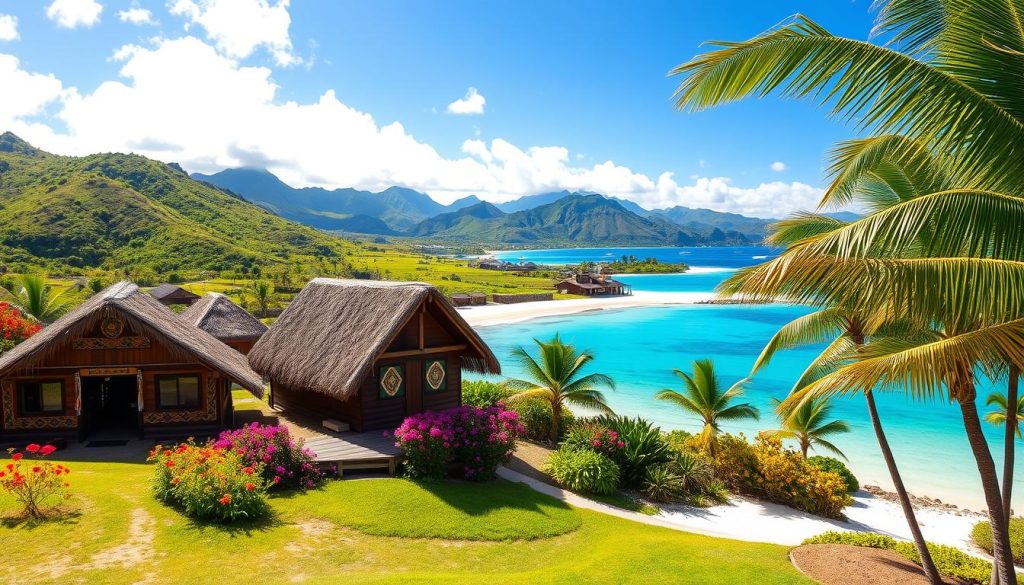
Exploring the Cook Islands’ language scene is interesting. Cook Islands Māori, or Rarotongan, is at the heart of local culture. Amazingly, 90% of people speak it well, making it a big part of everyday life.
“Language is the roadmap of a culture. It tells you where its people come from and where they are going.” – Rita Mae Brown
The Cook Islands have a great bilingual setup:
- English is common in cities and among the young
- Cook Islands Māori is key in local areas
- It’s similar to New Zealand Māori
| Language | Usage | Cultural Significance |
|---|---|---|
| Cook Islands Māori | 90% fluency rate | Primary local communication |
| English | Widely understood | Official government language |
Visitors should try to learn basic phrases in Cook Islands Māori. It helps talk to locals and respects their culture. The Te Maeva Nui Festival in late July is a big celebration. It shows off the language and cultural diversity of the Cook Islands.
Cook Islands Māori: The Heart of Cultural Identity
The Cook Islands Māori language is a vibrant link to the rich culture of Polynesian people. It’s an indigenous language deeply rooted in history. It plays a key role in expressing culture and identity for the Cook Islands community.
This language is part of the same family as New Zealand Māori, Hawaiian, and Tahitian. It forms a unique linguistic tapestry across the Pacific. About 27,000 people worldwide speak Cook Islands Māori, but fluent speakers are fewer.
Alphabet and Pronunciation Guide
Cook Islands Māori uses a modified Latin alphabet. It has some unique pronunciation features:
- Includes 15 letters: a, e, i, o, u, h, k, m, n, p, r, t, v, g, and w
- Vowel sounds are key to correct pronunciation
- Glottal stops and long vowels make unique sounds
Regional Variations and Dialects
The language shows great diversity across islands. There are several dialects, including:
- Rakahanga-Manihiki dialect
- Penrhyn dialect
- Rarotongan dialect (most widely spoken)
Modern Usage and Preservation Efforts
Keeping the Cook Islands Māori language alive is vital for cultural identity. Educational programs, community efforts, and digital resources are helping. They aim to keep the language alive for future generations.
“Our language is our soul, our connection to our ancestors.” – Local Language Preservation Advocate
| Language Preservation Initiative | Focus Area |
|---|---|
| Cook Islands Māori Dictionary | Published in 1995, documenting language research from 1957-1985 |
| School Language Programs | Integrating Cook Islands Māori into educational curriculum |
| Community Language Workshops | Teaching language and cultural context to younger generations |
English Language in the Cook Islands
English is a key part of the Cook Islands’ language mix. It’s an official language, helping people talk and connect. About 86.4% of the population speaks English, making it a big part of everyday life.
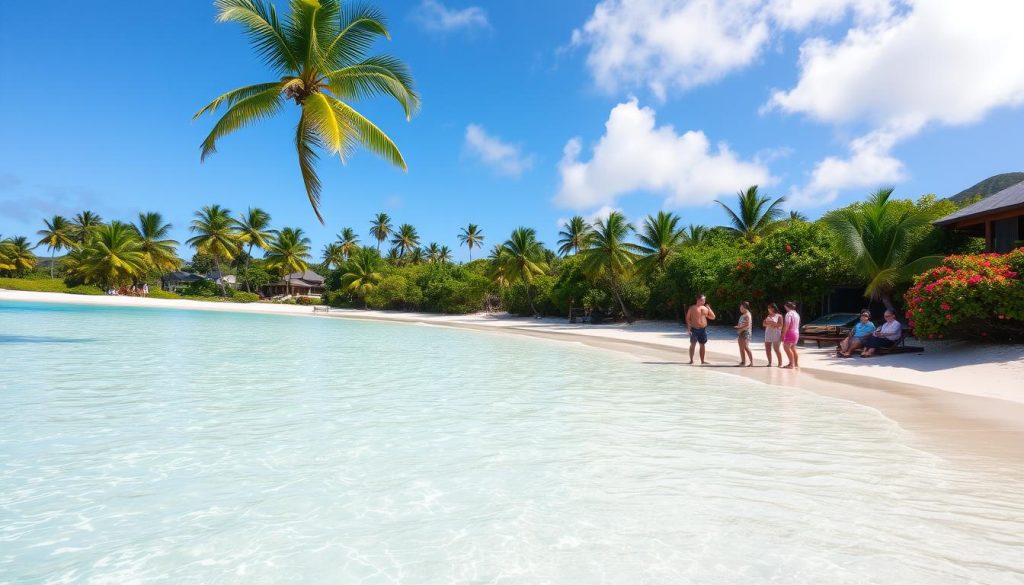
The Cook Islands have a special way of handling languages. English and Cook Islands Māori live together, creating a rich mix. This mix helps keep culture alive while also connecting with the world.
- Official status since 1965
- Widely used in government and education
- Essential for tourism and international interactions
“Language is the roadmap of a culture. It tells you where its people come from and where they are going.” – Rita Mae Brown
Knowing about English in the Cook Islands will make your visit better. English is used in many ways:
- It’s the main language in schools.
- It’s key for business talks.
- It’s crucial for talking to tourists.
| Language Context | English Usage |
|---|---|
| Education | Primary instructional language |
| Government | Official administrative language |
| Tourism | Primary communication method |
Visitors will find English very common. It makes traveling and talking easy. The Cook Islands value their languages and connect with the world, showing off their culture and global spirit.
Pukapukan: A Unique Northern Language
Explore the world of Pukapukan, a special indigenous language in the Cook Islands. It shows the rich culture of the northern islands.
Pukapukan is more than talking—it’s a symbol of its people’s culture. It’s different from Cook Islands Māori because it’s closer to Samoan.
Linguistic Characteristics
This language has a unique structure. Its alphabet has 15 letters:
- 5 vowels
- 10 consonants
Speaker Population
The story of Pukapukan is one of survival and moving. Here’s where its speakers are:
| Location | Number of Speakers |
|---|---|
| Cook Islands | 450 native speakers |
| Outside Cook Islands | Approximately 2,000 |
| Worldwide | Estimated 2,400 speakers |
Cultural Significance
“Language is the roadmap of a culture. It tells you where its people come from and where they are going.” – Rita Mae Brown
UNESCO says Pukapukan is “Definitely Endangered”. This shows how important it is to save it. The language tells the story of Pukapuka, a 2,000-year-old island.
Even with fewer people and more moving away, Pukapukan is still key to the community’s identity. Saving it is vital for the Cook Islands’ unique language heritage.
Penrhynese: An Endangered Island Language
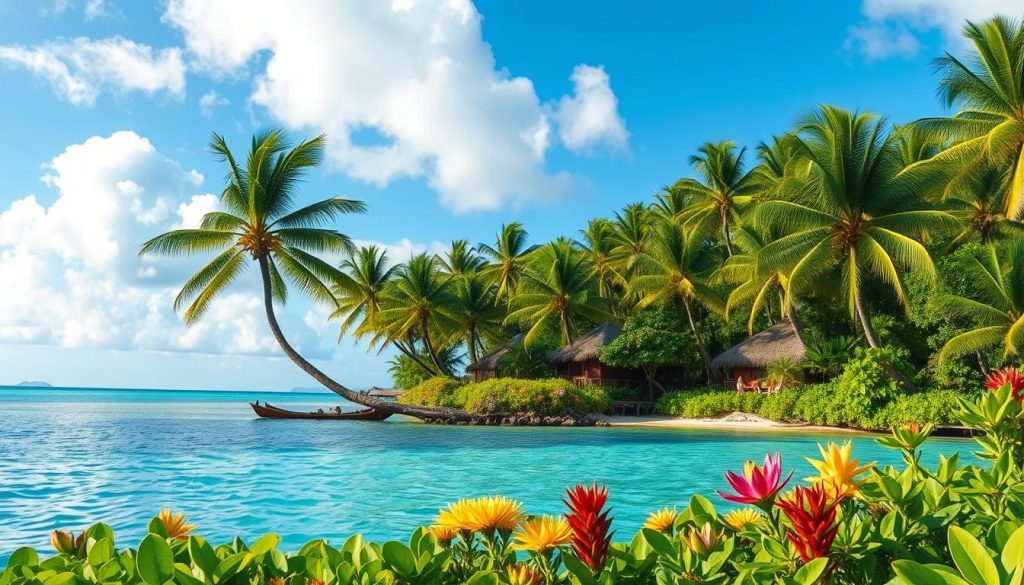
Penrhynese is found in the Northern Group of the Cook Islands. It’s a Pacific language with a rich history. Only about 200 people still speak it, making it very endangered.
Penrhynese has a unique way of speaking. It has 10 vowel sounds and 11 consonants. These sounds and patterns are special to the Penrhyn island community.
“Language is the roadmap of a culture. It tells you where its people come from and where they have been.” – Rita Mae Brown
Penrhynese faces big challenges. Younger people are learning more common languages. This could make Penrhynese disappear forever. Researchers are trying to save it by documenting its unique sounds and patterns.
It’s important to save Penrhynese. Community leaders, activists, and experts are working together. They’re making documents, learning tools, and teaching young people about their language.
Your help is crucial in saving Penrhynese. By valuing languages, we protect cultures and stories of human communication.
The Rakahanga-Manihiki Language
The Rakahanga-Manihiki language is found in the remote Pacific islands. It’s a key part of the indigenous languages’ story. This language shows the deep cultural heritage of the Cook Islands’ northern areas.
Geographic Spread and Population
The Rakahanga-Manihiki language is a story of survival. It has about 2,500 speakers. These speakers are not just in the original islands:
- About half the speakers live in the Cook Islands
- The rest are in New Zealand
- It’s connected to Cook Islands Māori but is different
Linguistic Characteristics
Rakahanga-Manihiki is closely tied to Cook Islands Māori but has its own identity. Cook Islands Māori speakers can understand some words, but there are big differences.
“Language is the roadmap of a culture. It tells you where its people come from and where they are going.” – Rita Mae Brown
This language shows the strength of indigenous Pacific languages. It keeps cultural details alive, linking communities across distances. Its survival needs ongoing efforts and community support.
Language Education and Policy
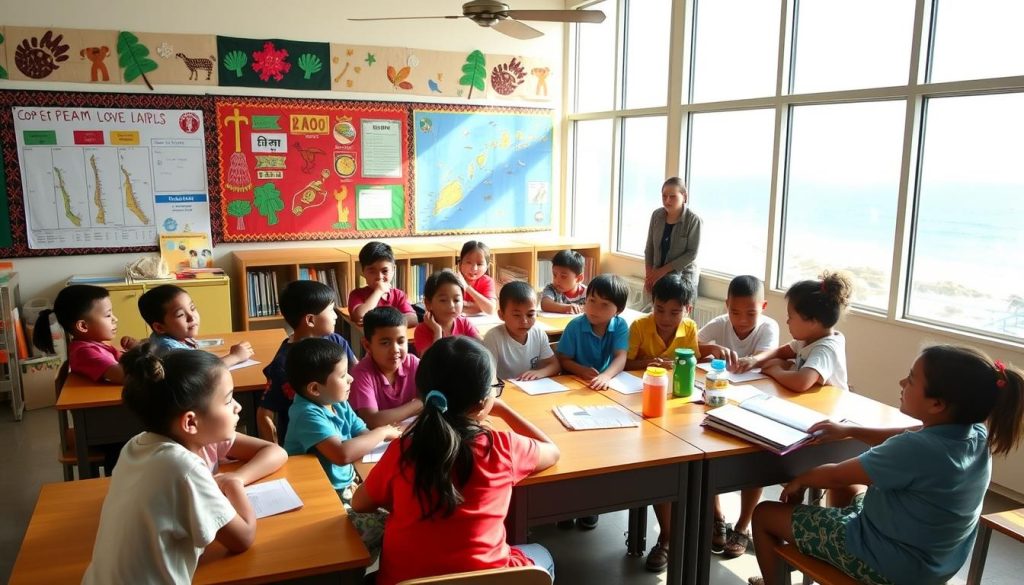
The Cook Islands have a unique way of handling language policies and education. They aim to keep multilingualism alive while preserving culture. In 2003, a big step was taken when Cook Islands Maori was made a national language. This move was crucial for protecting the language.
Understanding language education here means looking at a few important areas:
- Bilingual education system integrating Cook Islands Maori and English
- Government initiatives promoting indigenous language learning
- Challenges in maintaining linguistic diversity
The educational scene shows some interesting challenges. Over one-third of Rarotonga students struggle to reach minimum Maori language competency by Grade 4. This shows the ongoing fight to keep the language alive.
“Language is the roadmap of a culture. It tells you where its people come from and where they are going.” – Rita Mae Brown
Linguistic policies in the Cook Islands aim to protect Maori while also recognizing the need for English globally. The Northern Group islands have better Maori language skills than Rarotonga. This shows how language use can vary by region.
Looking into language education, we see a careful balance. It’s about keeping cultural identity strong while also meeting today’s communication needs.
Impact of Tourism on Language Use
The Cook Islands have seen a big change thanks to tourism. Visitor numbers went from 20,000 in the 1980s to over 160,000 in 2019. This big change has greatly affected how people speak and the languages spoken on the islands.
Tourism has been a key factor in how languages adapt in the Cook Islands. As people from all over the world visit, locals have found ways to keep their languages alive. They also meet the need for global communication.
Language Adaptation in Tourism Industry
The tourism sector has led to some interesting changes in language:
- More locals speak English well
- There are now multilingual tourism materials
- Culturally sensitive ways of communicating have been developed
Preservation Versus Modernization
Local communities are trying to keep their traditional Cook Islands Māori language alive. At the same time, they need to adapt to the demands of international tourism. Linguistic diversity is both a cultural treasure and an economic asset.
“Language is the roadmap of a culture. It tells you where its people come from and where they are going.” – Rita Mae Brown
Studies show that tourism can help communities grow. It can fund education and healthcare. The Cook Islands show how small islands can use tourism to protect their languages and culture.
Language in Daily Life and Business
In the Cook Islands, language use shows a lively mix of languages. This mix shapes how people talk and do business. With just over 17,000 residents, the islands offer a special place where English and Cook Islands Māori blend well in daily life.
Your experience with language in the Cook Islands will vary based on where you are. In Rarotonga, the main island, you’ll find:
- English widely spoken in business and tourism sectors
- Cook Islands Māori used in family and community settings
- Friendly locals who effortlessly switch between languages
Business talks mostly happen in English. This makes it simpler for visitors and business people from abroad to get around. Most work places focus on clear English, especially in:
- Tourism industry
- Banking services
- Government offices
- Retail establishments
“Language is the roadmap of a culture. It tells you where its people come from and where they are going.” – Rita Mae Brown
For travelers and business folks, knowing about local language can really improve your stay. While English is the main language for business, learning some Cook Islands Māori can help you connect with the locals.
Future of Cook Islands Languages
The survival of indigenous languages in the Cook Islands is at a turning point. With only 17,000 speakers worldwide, and fewer among the young, saving these languages is crucial. It’s key to keeping our culture alive.
- Only 9% of Cook Islands Māori in New Zealand speak their native language
- Te reo Māori Kūki’ Āirani is identified as a language at risk of disappearing
- Younger generations increasingly prefer English communication
Preservation Initiatives
Community efforts are underway to protect our languages. The Cook Islands government and local groups are working hard. They’re using smart strategies to bring back our indigenous tongues:
- Introducing language classes in schools
- Creating comprehensive learning resources
- Developing community language programs
Digital Language Resources
Technology is key in saving our languages. Digital tools are changing how we learn and document our tongues. Groups like the Cook Islands Language Commission are making cool digital stuff to get the young folks interested.
“Language is the roadmap of a culture. It tells you where its people come from and where they are going.” – Rita Mae Brown
| Language Preservation Strategy | Implementation Status |
|---|---|
| School Language Programs | Active |
| Digital Learning Platforms | Developing |
| Community Language Workshops | Expanding |
The future of Cook Islands languages looks bright. It’s all about keeping things fresh, getting the community involved, and using digital tools. This way, our indigenous languages will stay alive and meaningful.
Conclusion
Exploring the Cook Islands’ languages shows a world beyond words. It’s a deep connection to their culture. With English and Cook Islands Maori as official languages, they show strong support for keeping languages alive.
Traveling through the islands, you see how important these languages are. Cook Islands Maori has a unique alphabet and sound. It’s a challenge to keep these languages alive, especially with global influences.
Visitors and people worldwide can help preserve the Cook Islands’ languages. By respecting and learning about these languages, you support their culture. These languages tell stories of identity, resilience, and pride that link past, present, and future.
The story of language in the Cook Islands shows the importance of preserving culture. Whether you’re a traveler, linguist, or culture lover, learning about these languages connects you to this Pacific nation. The Cook Islands’ languages are a symbol of cultural strength and identity.
The above is subject to change.
Check back often to TRAVEL.COM for the latest travel tips and deals.
Here are some Tours & Sightseeing suggestions that might pique your interests!
